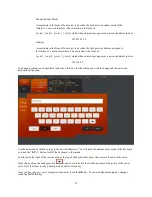
1
Chapter-1: Installation
Pre-Installation Tasks
Please take a few minutes to read through this chapter before proceeding with the installation of your new Omnia.11
processor.
About This Manual
The latest version of this manual is always available for download from the Omnia website here:
http://omniaaudio.com/manuals
Omnia.11 Components
By now, you’ve unpacked the shipping carton to gain access to this manual. Now is the time to inspect the
Omnia.11
unit and its shipping carton for any signs of shipping damage. Such damage must be reported to your
carrier for any claims. The Omnia.11 shipping box includes the following components:
Omnia.11 processor.
Omnia.11 Operating Manual.
Warranty Registration
Card. (Please complete the form and return/FAX it to Telos/Omnia)
Two IEC Power Cords, one of the USA/Canada style, and one of the Euro style.
Processor Location
We strongly suggest using the Omnia.11’s built-
in MPX stereo generator (the BNC Composite outputs) for the
analog FM channel if at all possible in your system. This will generally result in the best, most tightly controlled
modulation performance
. P
lus you’ll be able to make use of the advantages available only in the Omnia.11 such as
the SSB op
tion, superb pilot and SCA protection performance, composite clipping etc. Remember, analog FM is still
analog after all!
Using an AES/EBU digital
path to a digital exciter can be more convenient and can work well, but
it simply moves the location of the stereo generator D/A conversion to the digital exciter
over a third-party path
which is not likely to have the above advantages or
optimized pe
rformance
of the integrated stereo generator in the
Omnia. Sometimes, these exciters also have limiters or clipper
s built-in to their AES inputs that
can actually add
overshoot and distortion
to the signal!
AC Power Environment
The Omnia.11 subsystem is a DSP
-
based microcomputer, and therefore requires reasonably clean AC power, just as
any modern computer system does. And even though the Omnia.11 power supply is equipped with robust AC
transient suppression, we recommend that an “online” style (non
-
switching type) Uninterruptible Power Supply
(UPS) with transient surge suppression be employed.
At transmitter site
s there can be heavy transients on the power lines as well as significant surges introduced into the
power system by frequent lighting strikes. These are unwelcome power line events and can damage even the most
robust equipment. Therefore you should give the AC power environment and installation practices thorough
consideration before plugging in the Omnia.11 (or any other microcomputer
-
based equipment).






























